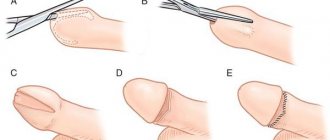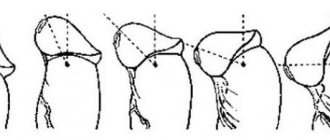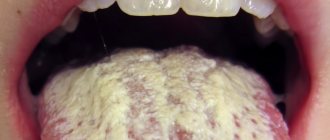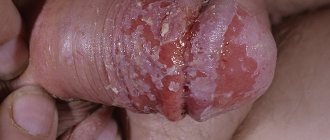Like other parts of the body, there are sebaceous glands called Tyson glands on the head of the penis and the inside of the foreskin.
They produce a thick secretion - spegma - the purpose of which is to protect the penis from friction against the foreskin or other damage. Normally, this lubricant has a milky color, but some physiological reasons or pathological processes can provoke a change in its consistency and the formation of a white coating on the head of the penis.
Attempting to cope with this problem on your own is dangerous and can lead to the development of serious complications. Therefore, if this symptom occurs, you should immediately seek the help of a urologist.
Spots on the skin of the penis - reasons for their appearance
White spots on the penis may indicate the following diseases and conditions:
- Allergies are the most common cause. The white spots are usually itchy. Symptoms often do not appear immediately, but several hours or even several days after skin contact with the allergen.
- Vitiligo is areas of depigmented skin. As a rule, they are found not only on the penis, but also on other areas of the skin. But such spots appear gradually. They may appear first on the skin of the penis. In the future, their growth is observed. The spots become more numerous, they merge, appearing on the scrotum, pubis, as well as areas of the skin remote from the genitals.
- Lichen sclerosus is a precancerous pathology. The spots are localized on the head. This is a type of limited scleroderma. Synonyms: guttate morphia, Tsumbusha's lichen alba, white spot disease, lichenoid scleroderma, atrophic punctate leukoderma. The inflammation is autoimmune in nature. It is not spots that appear, but plaques – that is, they are dense and characterized by thickening of the skin.
- Hypertrophy of the sebaceous glands - small white spots appear on the penis. This is the norm, not a pathology. Hypertrophic sebaceous glands are unsightly, so they are sometimes removed for aesthetic reasons. But they do not threaten health.
- Psoriasis is a systemic disease that can begin in the genitals. Silvery plaques with peeling appear. Often found on the head.
- A tumor can look like anything, including a white spot on the skin of the penis. The growth of the spot and especially its manifestation should cause oncological alertness.
- Setton's nevus is a pigment spot that looks like an area of hyperpigmentation (mole) in the center and a focus of lack of pigment on the periphery. It looks very similar to vitiligo. Treatment is required only for aesthetic reasons.
- Scars - if the skin was damaged and then restored, then it is lighter than the surrounding skin. The cause may be injury, chafing, previous herpes or other inflammation, surgery and minimally invasive procedures. A white ring around the penis may appear when rubbed with a condom. Small spots form after acne resolves.
Diagnosis of pearly papules
The diagnosis is made based on a clinical examination by a urologist or dermatovenerologist. If the change is accompanied by symptoms of inflammation - redness, swelling and itching - another etiology should be considered.
They are often confused with condylomas (genital warts), which are sexually transmitted diseases caused by HPV infection. The misconception can be easily eliminated with the help of a biopsy and microscopic examination of this change - a different number of dilated thin-walled blood vessels, proliferation of fibroblast cells and connective tissue are observed.
What does a white spot on the penis look like?
For different diseases, white spots on the penis look different:
- vitiligo - spots of different sizes with clear boundaries, irregular shape, can merge, are multiple, do not rise above the skin level
- Setton's nevus - looks the same as vitiligo, only there is a mole in the center (sometimes the mole disappears, but the depigmented spot remains)
- psoriasis – silvery, dense plaques with small scales
- scars - may be denser than the surrounding skin, rise above it or fall below the level
- lichen sclerosus - multiple small (no more than 1.5 cm) white papules rising above the skin level (can merge into irregularly shaped plaques)
Diagnosis and treatment
Treatment of diseases of the male reproductive system, including treatment of STDs, is the responsibility of urologists and andrologists. In case of an infectious lesion, therapy is prescribed by a venereologist. The cause of plaque on the penis is diagnosed based on the results:
- visual medical examination;
- studying the patient's premorbid background;
- laboratory tests: OCA and blood biochemistry, urethral smear, urine test;
- ultrasound examination of the pelvic organs.
Based on the results of the examination, the doctor chooses treatment tactics, determines medications, dosage and duration of the therapeutic course. For bacterial, prokaryotic, and parasitic infections, antibiotics are prescribed. Candidiasis is treated with antimycotics in tablets and ointments. For diabetes and psoriasis, basic treatment and diet therapy are adjusted.
Preventive measures help prevent unpleasant manifestations - careful genital hygiene, barrier contraception, strengthening the immune system and following the recommendations of the attending physician (for chronic diseases).
An important point is a timely visit to a urologist, both in the event of symptomatic complaints and for prevention. Make an appointment
Are white spots on the penis dangerous?
Usually white spots on the penis are unpleasant, but not dangerous. The exceptions are:
- psoriasis
- lichen sclerosus
- penile cancer
Psoriasis is dangerous in itself. Spots on the testicles or penis do not directly pose a threat to life. Psoriasis can affect large areas of the skin as well as internal organs.
Lichen sclerosus on the penis is not dangerous for 95% of people. But in 5% of cases it transforms into squamous cell skin cancer.
The most dangerous white spots on the penis are associated with a malignant tumor. It is rare to die from this type of cancer, as there are effective surgical treatment methods. But partial or complete removal of the penis dramatically reduces a man’s quality of life.
Causes of white plaque
The causes of white plaque on the penis are classified into three groups:
- physiological. Associated with the peculiarities of the secretion of tyson glands located under the foreskin. The problem is aggravated by the lack of proper hygienic care of the genitals;
- non-infectious (endogenous). Caused by disruption of internal organs. Whitish accumulations on the penis are a concomitant symptom of chronic diseases or a sign of activation of opportunistic microorganisms that are part of the natural microflora of the body;
- infectious (exogenous). These are sexually transmitted diseases (STDs).
In the first case, it is enough for a man to get medical advice. To eliminate other causes, proper treatment is required.
Foreskin
Understanding the anatomy and function of the foreskin makes it possible to appreciate its importance for the normal functioning of the penis.
The foreskin, or prepuce, is essentially a “flap” of skin, a two-layer fold covering the head of the penis.
Rice. Development of the prepuce in utero
Before birth, the foreskin is attached to the glans penis by a layer of epithelial cells called synechiae (black lines in the pictures). By the twenty-fourth week of intrauterine development, the formation of the foreskin ends. However, the leading edge continues to grow forward after birth.
Gradually, in the first years of a child's life, the foreskin is separated from the head of the penis . The duration of this process is extremely variable and can end by the birth of the child or continue until adolescence . And if this does not happen naturally, we recommend separating the foreskin from the head of the penis no later than 5-6 years of age, in order to avoid infectious complications.
In adulthood, the penis must become erect in order to have sexual intercourse. At the same time, the penis increases in length by fifty percent. Since the foreskin is a double fold of skin, it allows the penis to lengthen freely during an erection.
Microscopic examination confirms the fact that the foreskin is not only skin involved in erection, it is also richly innervated and blood-supplied.
During sexual activity, the tissues of the foreskin respond to stimulation. The sliding of the prepuce over the skin of the glans penis activates nerve endings, increasing sexual arousal and contributing to the achievement of an erection. In addition, the mucous membrane of the inner layer of the foreskin performs a specific function during masturbation and sexual activity.
The structure of the foreskin
The structure of the foreskin includes:
- Outer layer of foreskin;
- Inner layer of foreskin;
- The preputial ring is elastic tissue, the junction of the outer and inner layers of the foreskin. When not erect, the preputial ring narrows and allows the prepuce to remain on top of the glans penis. Many men note that this area of the foreskin is the most erogenous.
- The coronal groove of the penis is located immediately behind the crown of the glans, at the junction of the head and the shaft of the penis. The inner leaf of the prepuce is also attached here.
- The preputial space is the space between the foreskin and the head of the penis.
- The frenulum of the penis is a fold of skin located on the lower surface of the penis under the head and attached to the inner foreskin. The frenulum of the penis is a highly erogenous zone . During circumcision, the frenulum is also resected, completely or partially. For a better aesthetic effect during circumcision, we prefer to form a new frenulum. There are situations when the length of the frenulum is not enough to properly expose the head, which can lead to its ruptures or regular microtears with subsequent scarring of the skin. Such situations require plastic surgery of the frenulum of the penis. In some patients, frenuloplasty or circumcision is the only way to treat premature ejaculation that allows one to achieve good results.
The preputial space is normally always slightly moist . glands in the foreskin that produce cathepsin B, lysozyme chymotrypsin, elastase, cytokines and pheromones, for example, androsterone, etc.
Sensitivity of the foreskin
We will pay special attention to the sensitivity of the foreskin, since it is the large number of nerve endings located in the prepuce that provide sensations during sexual intercourse.
The most sensitive areas of the penis:
- Comb ring , also called Taylor's ring (named after the scientist who first described it). Taylor's ring is an area of highly wrinkled mucous membrane lining the inner surface of the apex of the prepuce.
Along the lower surface of the penis, the ring passes into the frenulum of the penis. The Taylor ring contains a huge number of receptors that respond to stretching, trigger the sexual reflex and are responsible for erogenous sensitivity.
When the preputial ring is stretched as it passes through the head of the penis, the receptors are stimulated, which causes a feeling of satisfaction.
- The frenulum of the penis provides a man with a feeling of pleasure due to its stretching during sexual intercourse. Around the world, the frenulum is also known as the “sex nerve”.
There are more nerve endings in the frenulum than in the head; these nerve endings are called Meissner's corpuscles.
- The coronal sulcus of the penis has good innervation, and stimulation of this area can be a trigger for ejaculation.
The glans penis has poorer innervation and, therefore, less sensitivity in contrast to the above structures.
Foreskin dimensions
The absolute size of the foreskin in children is small; during growing up and puberty, the prepuce gradually increases in size. The size of the foreskin is highly variable. In adult men it is 96.7 square meters. centimeters or more. Taylor's studies found that the length of the foreskin in an adult male varies from 4.8 to 9.3 cm (average size 6.4 cm). The prepuce may partially cover the head or, conversely, protrude beyond the boundaries of the head of the penis.
Defense mechanisms of the foreskin
The foreskin is equipped with a number of defense mechanisms against infection. Firstly, this is achieved due to the sphincter, which ensures a tight fit to the head of the penis and prevents foreign bodies from entering the preputial space. The secretion of the preputial space contains lysozyme and other substances that destroy pathogens. On the other hand, the frenulum is a site of accumulation of Langerhans cells, which can serve as a gateway for sexually transmitted infections, including HIV infection, to enter the body.
In fact, in the modern world , when men maintain hygiene every day, the protective mechanism has lost its acute relevance.
Movement of the foreskin
1st picture. The area between the upper and lower lines is the outer foreskin. The external prepuce is approximately the same length as the skin covering the shaft of the penis. The internal prepuce is equal in length to the external foreskin and is not visible.
2nd picture. The foreskin is moved by hand by about 2 cm. The area between the upper and lower lines is represented by the outer foreskin. The area under the lower line is the internal prepuce (about 0.5 cm).
3rd picture. As in the previous pictures, the area between the upper and lower lines is the external prepuce. Between the glans and the inferior line is the inner foreskin, which is gathered behind the crown of the glans.
4th picture. The foreskin is retracted even further. At the same time, the folds of the inner foreskin straightened.
5th picture. The foreskin is retracted as much as possible. The area between the line and the head of the penis is the fully extended internal prepuce. The entire body of the penis is covered by the foreskin, with most of it being the internal prepuce. The picture clearly visualizes veins, arteries, capillaries and the smooth head of the penis.
Movement of the foreskin during erection
During an erection, the penis increases in size by 50%. The movement of the foreskin occurs similarly to that described above.
Functions of the foreskin
1. Functions related to sexual activity
- The foreskin functions as an erogenous tissue, especially through the sensitive Meissner corpuscles and Taylor's ring.
- By sliding back and forth during intercourse, the foreskin helps reduce friction, thereby increasing comfort for both partners.
- The foreskin facilitates penetration (insertion of the penis).
- During sexual intercourse, the foreskin allows for shorter and smoother movements, and promotes closer contact with the woman's pubic promontory.
- The foreskin is involved in the release of lubricants during sexual intercourse.
2. Protective functions of the foreskin
- Protects the head of the penis from injury and damage.
- In early childhood, the foreskin protects the head of the penis and the external opening of the urethra from contamination and infection.
- In early childhood, the foreskin prevents inflammation, ulceration and stenosis of the external opening of the urethra.
- By producing lysozymes and other immunoglobulin factors, the foreskin has a bacteriostatic effect on microorganisms that enter the glans.
Back to articles










